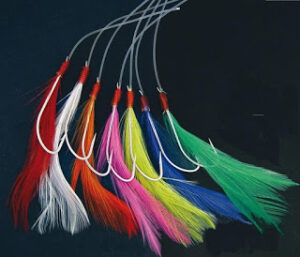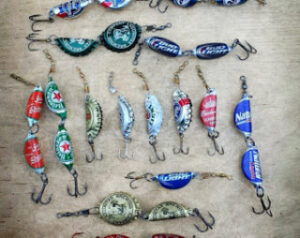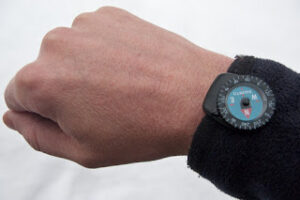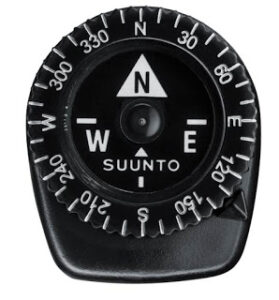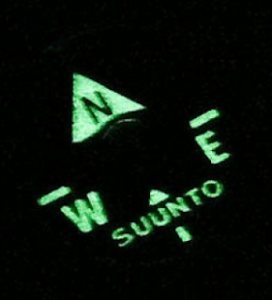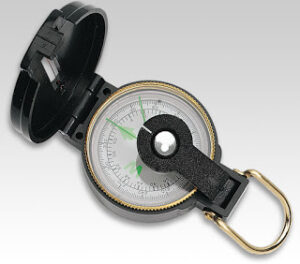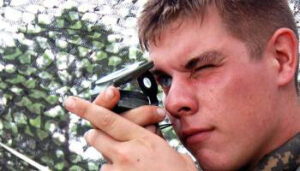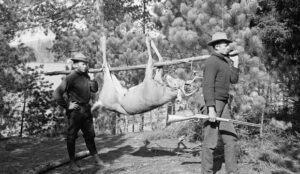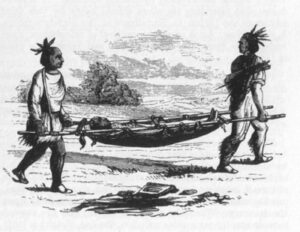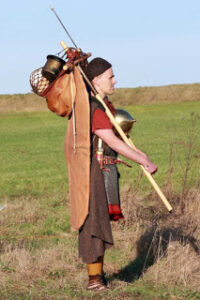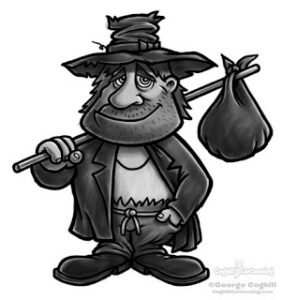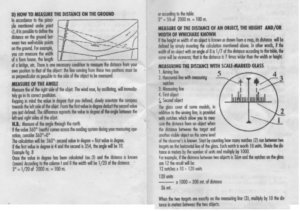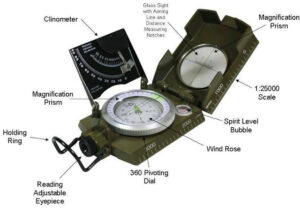
This map of the world shows magnetic declination in different parts of the Earth’s surface. Since magnetic north is moving, this map will be out of date when you read it.
Note that declination has very little correlation with longitude.
The green line shows the agonic line. If on this line a compass will point towards true north.
On the isogonic lines, declination may be more than 20° in the northern hemisphere and even greater values as we travel south. Easterly declinations are in red. Westerly declination are in blue and given as a negative number.
So what effect does magnetic declination have on navigation?
Suppose I am in an area where the declination is 2° west. I’m facing a direction the compass tells me is north, 0°.
I notice something of interest ahead of me and try to locate it on my map. Rather than being on the north-south line the point of interest will actually be at a bearing of 358° from my position on the map. 0° is the same as 360° so 2° west gives 358°.
In another part of the world. I might face towards magnetic north but in fact be facing at a bearing of 13° east, a significant difference.
Magnetic declination will probably be marked in the margin of your map. Some maps have a declination in each corner of the map. Use the value closest to your position on the map. If you are midway or in the centre average the relevant values.
Note that the declination diagram is not drawn to scale. Don’t try to measure it with your protractor, use the values given in the text.
To make our life more interesting, magnetic north moves over time. The magnetic declination information will include an annual rate of change so you can calculate how much the declination has changed since the map was printed.
An old map I have of London tells me the magnetic declination for June 1989 was 6°W and that this was expected to change by 9'E every year.
In 2001 it would therefore be expected to be 4.2°W.
In 2016 this map predicts magnetic north will have shifted by 243' from what it was in 1989. There are 60' in a degree so 243' is 4° 3' and predicts magnetic declination in London would be 1° 57' west by 2016.
This website gives the magnetic declination in London in 2016 as actually being 2° 10' west.
In practice, declination is rounded to the nearest half degree/30' or 10 mils. so we would treat both 1° 57' and 2° 10' as 2°.
The difference does illustrate that not only does magnetic declination change over time, but the rate of change may also vary.
If using old maps. it is important to get up-to-date information.
Once you have an up-to-date magnetic declination, what do you do with it?
This is where a lot of people get confused.
Declination, or G-M angle, is the difference between grid north (GN) and magnetic north (MN). The magnetic north line may have half an arrowhead or a barb. The declination diagram may also include true north, often marked with a star (★).
When do you add it, when do you subtract it? Some maps will give you this information, relevant for the area covered in the map. Where present, follow these instructions.
When a map lacks this information, there are lots of rhymes and aide memoires that have been created to teach you what to do. Some of these, however, are only “true” in certain parts of the world.
Many readers will have been taught use the acronyms “MUGS” and “GUMA”. These stand for “Magnetic Unto Grid: Subtract” and “Grid Unto Magnetic: Add”.
A related rhyme is “Magnetic to Grid, get rid” and “Grid to Mag, Add”. Another acronym pair is “MUCA” and “CUMS”. The “M” stands for map and the “C” for compass in this case, but when stressed you might confuse these with “magnetic” and “chart”, so I find MUGS and GUMA safer, and LARS even better.
What MUGS means is that if you have a magnetic bearing, taken with your compass, you must subtract the magnetic declination before plotting the angle on your map. In our example above the magnetic bearing of 0°/360° has the declination of 2° subtracted from it to give the actual bearing of 358°.
When converting a bearing on the “grid” to a magnetic bearing you add the declination (GUMA).
I suspect that the MUGS/GUMA acronyms are probably British Army in origin, since they tend to favour a westward declination and could be used in the UK and most of Western Europe.
To make MUGS/GUMA global in application, we needed to learn one more thing: “West is Best, East is Least”.
“West is Best, East is Least” tells us to treat a west declination as positive and an easterly one as negative.
As you should know, subtracting a negative number adds the value of the number to the total. Adding a negative number subtracts the value.
Hence, from the above examples:
0°/360°(magnetic) – 2°W = 360°-2° = 358° grid (MUGS)
0°/360°(magnetic) – 13°E = 360°- (-13°) = 0°+ 13°= 13° grid (MUGS)
(It is possibly more logical to treat a westward declination as negative, giving us the rather nice acronyms of “MUGA” and “GUMS”. MUGS and GUMA are very well established, however.)
As I update this article in February 2024, magnetic declination in London is now 1°51' East.
This uses the declination diagram on the map. You need to move right/clockwise to get from a westerly magnetic north line to the grid north line, so you subtract the G-M angle to convert from magnetic to grid azimuth. From the grid line to magnetic north is left/anticlockwise, so add the difference for calculating magnetic from grid.
For an easterly declination, the grid line will be to the left/anticlockwise of magnetic north, hence magnetic to grid adds the G-M angle and grid to magnetic (right/clockwise) subtracts in this case.
I recommend that you learn and use the LARS method.
Treat the G-M angle as an absolute value (always positive) and follow LARS: Left Add, Right Subtract.

The method in the illustration above will be familiar to many compass users.
Rather than aligning the needle with the “N” arrow on the face it is possible to compensate for magnetic declination by holding the needle pointing at the declination value on the dial.
Hence if the local declination is “10°W”, you hold the compass so the needle points to the “350°” mark on the bezel rather than “0°”.
You may use LARS to calculate the offset (the value the needle should point at).
You are making a magnetic bearing into a grid one.
MAGMGA: Magnetic Azimuth +/- G-M Angle = Grid Azimuth.
For a easterly declination (East/Left Add) add the G-M angle to 0.
For an westerly (West/Right Subtract) , subtract the G-M angle from 360°/6400 mils.
As a check, the needle and the north mark should resemble the declination diagram. In other words, if the G-M angle is easterly, the needle should be to the right/clockwise of the north mark.
This is useful when walking to a bearing, although you are better walking towards a landmark rather than walking staring at your compass (or phone!) all the time.
When sighting with a compass, the values you will get will still need conversion.
Remember that metal objects on your person or in your surroundings may affect a compass reading. Overhead power cables may influence the needle from as far as 55 metres away!
“West is Best, East is Least”
MUGS
GUMA
LARS
